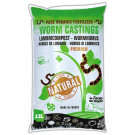 Vermicompost: green amendment , content of beneficial microorganisms
Vermicompost: green amendment , content of beneficial microorganisms
Vermicompost is produced by digestion of various organic manures and wastes by earthworms.
It uses two kinds of compost worms (Eisenia, dandrobena) because they consume a tremendous amount of waste and are very robust. They eat decaying organic matter and then reject the waste in small droppings or twisted by enriching the soil
 Vermicompost outperforms the compost!
Vermicompost outperforms the compost!
It is generally believed that vermicompost outperforms compost, in regard to levels of microbial activity. In this area, it owes much to the Ohio University and Dr. Clive Edwards (Subles et al., 1998).
In an interview (Edwards, 1999), he asserts that vermicompost could be 1000 times more active than conventional compost in terms of microbial activity, although this rate is not always achieved.
And he continues: These are micro-organisms more capable of converting nutrients and making them more easily absorbed by plants as those found in compost. In the compost, they are thermophilic microorganisms. The range of micro-organisms is quite different and far more beneficial in a vermicompost.
I reiterate what I have said repeatedly: a vermicompost is much better than a compost, if one seeks to stimulate plant growth. "
 7 good reasons to use vermicompost
7 good reasons to use vermicompost
. Superior to ordinary compost
. Increases resistance to disease
. Stimulates growth
. Multiplies the taste of fruits and vegetables
. Facilitates root
. Can be mixed with any soil
. Used in organic
 Ability to stimulate plant growth
Ability to stimulate plant growth
This is the area where we got the most interesting and compelling results.
Many researchers have found that vermicompost further stimulates plant growth even though they are already receiving optimal nutrition.
Atiyeh et al. (2002) conducted an elaborate analysis of the literature on this phenomenon. They stress that "these studies have shown repeatedly that organic waste vermicomposted have beneficial effects on plant growth independent of nutritional changes and availability. Whether used as amendments or introduces into the horticultural soil aboveground , vermicomposts have repeatedly improved the germination, growth and seedling development, and increased plant productivity much more than that it would be possible with the simple transformation of mineral nutrients to make them more available. "
In addition, the authors report a discovery already reported by others (Arancón, 2004): The Contribution of vermicompost maximum benefit is obtained in proportions of 10 to 40% of the culture substrate. It appears that above 40%, the contribution of vermicompost is no longer beneficial and may even result in reduced growth or yield.
Atiyeh et al. consider the possibility that the observed responses in terms of growth are due to a hormone-like activity associated with high levels of acids hunomic and humates in vermicomposts: "It is quite possible that [...] growth regulators, which are relatively transient, are adsorbed to humate and act in concert with them to influence plant growth. "
This important concept - the vermicompost is supposed to contain growth regulators beneficial for growth and performance - has been mentioned and has been further studied by several researchers (Canellas et al., 2002).
In Argentina, farmers who use vermicompost believe it is seven times richer than compost and therefore requires a seventh of the quantity required.
The findings of Australian and Indian farmers are in the same direction (Vermitech, 2004; Bogdanov, 2004). The literature on the subject agrees about the benefits of vermicompost ranging from growth and yield greater resistance to disease and even the ability repellent. OACC's own research suggests that vermicompost has benefits distinct from those of ordinary compost, although this does not necessarily apply to all cultures and all situations.
Ferme Lombricole du Moutta - Vermiculture Farm of Moutta © - Legal notice - Realization axyneT







